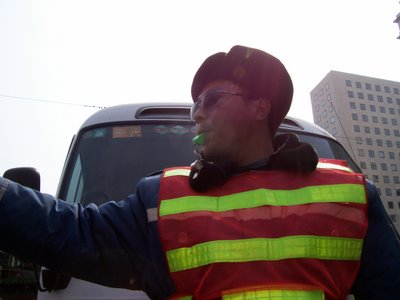
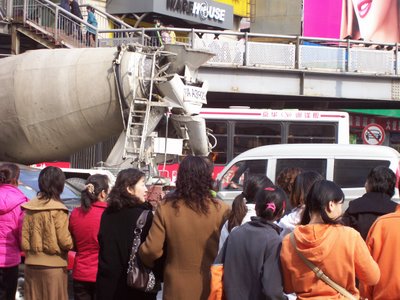 A visit yesterday to the bus, car, cement truck, bicycle, and pedestrian combat zone of the Xidan shopping district proved a failure as far as finding an english-chinese textbook, but a success as far as escaping back into the subway un-runover'd. Fortunately, I was able to find some decent looking books today back again on Wangfujing, a shopping district thankfully reserverd for pedestrians and the occasional tourist trolley. It seems as though there is no district in Beijing that is not a shopping district, besides the squeezed in spaces where people have lived for centuries, the alleys, hutongs. Below a doorway someones home.
A visit yesterday to the bus, car, cement truck, bicycle, and pedestrian combat zone of the Xidan shopping district proved a failure as far as finding an english-chinese textbook, but a success as far as escaping back into the subway un-runover'd. Fortunately, I was able to find some decent looking books today back again on Wangfujing, a shopping district thankfully reserverd for pedestrians and the occasional tourist trolley. It seems as though there is no district in Beijing that is not a shopping district, besides the squeezed in spaces where people have lived for centuries, the alleys, hutongs. Below a doorway someones home.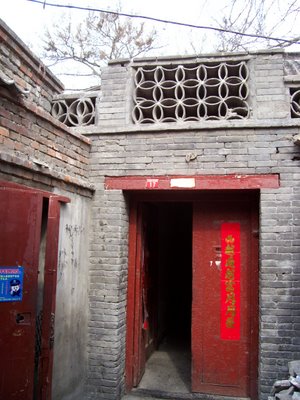
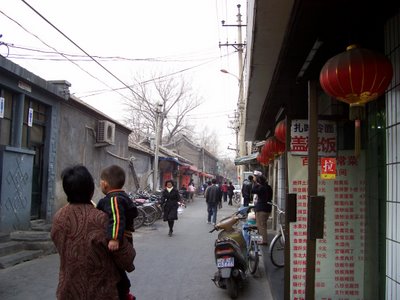 But as the hutongs are famously charming they are also famously dissapearing at a rate of 10,000 dwellings a year. I have not yet toured the hutongs, besides those dramatically scruffy ones behind the glitzy modern Wangfujing street (below) and the quieter ones flanking the Forbidden City.
But as the hutongs are famously charming they are also famously dissapearing at a rate of 10,000 dwellings a year. I have not yet toured the hutongs, besides those dramatically scruffy ones behind the glitzy modern Wangfujing street (below) and the quieter ones flanking the Forbidden City. 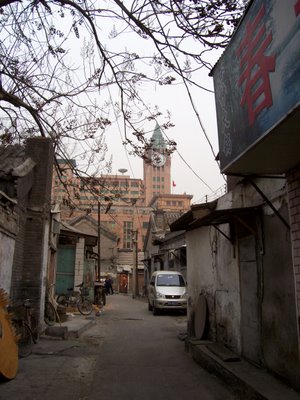
This makes up the less aromatic backside of Chanel, and Nike, and the rest of the veritable Champs-Elysee of China. Entering only the merest of entry-ways between the fancy stores... ...may find you behind a building looking out onto a space such as this:
...may find you behind a building looking out onto a space such as this:
...a bulldozed lot waiting to have a multi-story department store poured into it. Formerly, no doubt, it was a hutong that had probably stood for centuries. This was the sidewalk to Snack St. Some people I passed looked dismayed to see that the buildings weren't there when they were only a week ago. They thought they were on the wrong sidewalk.
The hutongs surrounding Tian'anmen and the Forbidden City, were back in the day of the dynastic emporors, the neighborhoods of the servants and laborers of the emporor. The long alleys hutongs were created by adjacent court-yard houses, siheyuan. The hutongs were named after the families who lived there, or after storehouses that were contained in them, such as "Curtain Storehouse Alley" or "Lantern Storehouse Alley." They were also named after the workers who supplied labor and crafts to the Forbidden City such as "Big Stone Mason's Alley" or "Wet Nurse Alley." This is the famous Wangfujing Snack St., formerly a hutong, now a "snackstreet." 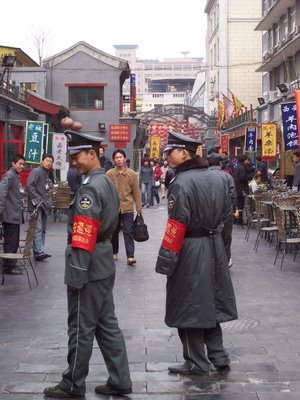
The hutongs have seen many generations, thus admittedly, most were in serious disrepair. Many hutongs still lack indoor plumbing and toilets. Though the siheyuan may have been passed down through the family, all property is still owned by the government, which probably explains the ease of their removal. However, some of the more scenically situated hutongs (next to tourist spots) are being preserved by the government. The redevelopment of Beijing's select hutongs is a process of gentrification identical to the face-lifting of American downtowns. For those who can afford to live in the charming vernacular dwelling, they must pay handsomely. I suppose its something better than razing them down completely and erecting a white-tiled tower in its place. 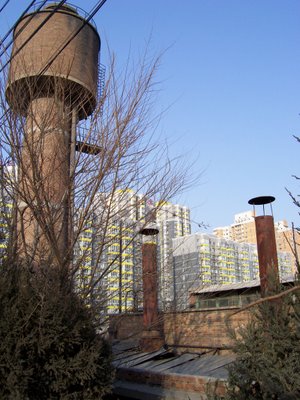
Indeed, there will be no lull in the insane level of development in Beijing. Really, impressively dizzying. It is fastly approaching, or perhaps already the glimmering (and grey?) skyscrapper landscape of the future. And if China is not short of one thing it is man-power. The creation of a clean efficient futurama creates millions of jobs. Obvisouly there are engineers, bankers, realtors, conscruction, and waitstaff, but there are way more lower-order jobs created, if not just to create jobs. The city cleaners are my favorite government employee, apart from the painfully unnoticed traffic cops, and the gaurds that sit/sleep in lawn chairs in the subway tunnels. The city cleaners are given a grungy orange bike with a hollowed drum attached for dirt and trash, and a broom made out of twigs and dried grass, and a orangish pair of pants. They "patrole" the streets and can be seen sweeping intersections after every green light. I once followed one women as she dusted every orange pay phone hood on the street. I was want to find the pay phones prettier, but it never happened.
But this process of urban employment is geogaphically baised to those areas that are undergoing rapid development. The rural areas are being gutted of its younger workforce. I have read that as you enter smaller villages you are welcomed by seniors and children because everyone else has gone to find work in the cities. Its the tale of mass urbanization and industrialization that has played out in all developped countries. Some have been better able at conserving some heritage in the process (i.e. France) but with those with more population at stake it plays out as first 1.) development at all costs, and only after dams start bursting, rivers become toxic, and no one wants to come to your country because it stinks and there are no trees and vernacular dwelllings left that 2.) the "guiding hand" actually starts guiding, if perhaps only regulating (i.e. saving some hutongs for the tourists and middle-class).
I leave you with the cold sunset I found leaving the school today. Looking out upon the gap between a white building and a karaoke (KTV) club.

